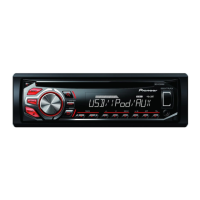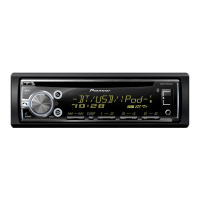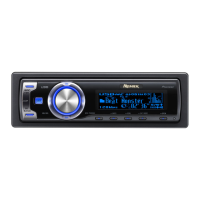Do you have a question about the Pioneer DEH-X2650UI and is the answer not in the manual?
Expresses gratitude for the purchase and advises reading the manual.
Provides important safety warnings and precautions for handling the unit.
Details the functions and locations of buttons on the DEH-X3650UI and DEH-X2650UI head units.
Explains the functions and layout of the remote control for operating the unit.
Illustrates various indicators and symbols shown on the unit's display.
Guides users through the initial setup process, including clock, FM/MW tuning steps.
Provides instructions on safely removing, storing, and re-attaching the detachable front panel.
Explains how to select audio sources and adjust the volume using the unit's controls.
Covers proper use, maintenance, and battery replacement of the remote control.
Details basic radio functions like selecting bands, tuning stations, and storing presets.
Explains how to switch display information and tune radio stations using PTY functions.
Covers various settings like BSM, REGIONAL, LOCAL, TA, AF, NEWS, and SEEK for radio operation.
Details basic operations for playing CDs and USB devices, including file management.
Covers switching between audio sources and operating the MIXTRAX function.
Explains how to select and play files from discs and USB storage using name lists.
Details functions like repeat play, shuffle, pause, and sound retriever.
Guides users on playing songs, navigating, and controlling playback on an iPod.
Details MIXTRAX operations and how to switch display information for various media.
Explains how to browse, search, and play songs from an iPod using different methods.
Describes how to switch between unit control and iPod control modes for iPod operations.
Explains how to adjust audiobook speed and use the sound retriever function.
Covers requirements, limitations, and setup procedures for streaming Pandora, especially for iPhone users.
Details how to select, sort, play, and delete shuffle/station lists for radio or other sources.
Explains how to give thumbs up/down for Pandora tracks and configure Bookmark, New Station, and Sound Retriever.
Discusses using connected device applications, compatibility, and setup procedures for iPhone users.
Details how to adjust audio settings like Fader, Subwoofer, and SLA for optimal sound.
Explains how to adjust fader, balance, equalizer settings, and loudness for audio output.
Details subwoofer on/off settings, subwoofer adjustment, bass boost, and HPF settings.
Covers system settings like display info, clock, auto PI seek, AUX, and dimmer.
Explains how to activate Pandora and customize key/display illumination colors and effects on the DEH-X3650UI.
Provides an overview of MIXTRAX technology and its associated menu functions.
Details how MIXTRAX effects change with audio levels and how to control display effects.
Guides users through setting up the initial menu and system menu, including FM/MW steps and display options.
Explains how to use an AUX source and manage the unit's display, including turning it off or troubleshooting unwanted displays.
Provides essential connection guidelines, speaker requirements, grounding instructions, and safety warnings.
Details the wiring connections for the unit's power cord and various outputs, including diagrams.
Explains specific connections for subwoofers and optional power amplifiers, including wiring details.
Covers important installation precautions, mounting procedures for DIN front/rear types, and unit removal.
Briefly mentions front panel removal and provides detailed troubleshooting for common display issues and unit malfunctions.
Lists common error codes for AMP, CD player, and other issues, with corresponding troubleshooting steps.
Explains various status messages and error codes related to USB storage devices and iPods.
Covers common Pandora error messages, status indicators, and operational limitations like skip limits.
Addresses radio status messages like STATION FULL, CAN'T DELETE, and issues with app startup.
Provides guidelines for handling discs, USB devices, and iPods, including compatibility and settings.
Details the compatibility of WMA and MP3 compressed audio formats for discs and USB devices.
Lists detailed specifications for WMA and MP3 audio files, including bit rates and sampling frequencies.
Outlines compatibility details for discs and USB storage devices, including folder structure and file limits.
Specifies compatible iPod models and software, and explains how to manage audio file sequences.
Lists copyright information and trademarks for various software and technologies used in the product.
Provides detailed technical specifications for the unit, covering general, audio, tuner, and CD player parameters.
| MP3 playback | Yes |
|---|---|
| Playback disc formats | CD audio |
| Audio formats supported | MP3, WAV, WMA |
| Output power | 50 W |
| Product color | Black |
| Volume control | Rotary |
| CD changer capacity | 1 discs |
| Disc types supported | CD, CD-R, CD-RW |
| Audio output channels | 4.0 channels |
| Equalizer bands quantity | 5 |
| Supported radio bands | AM, FM |
| Display type | LCD |
| Display number of colors | Monochrome |
| Bluetooth | No |
| USB version | 2.0 |
| USB ports quantity | 1 |
| RMS rated power | 200 W |
| Compatible products | iPod\\r iPhone\\r Android |
| Key illumination color | Red |











